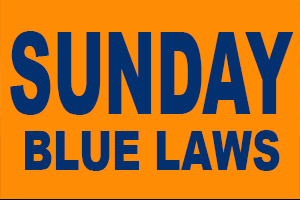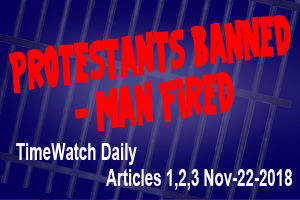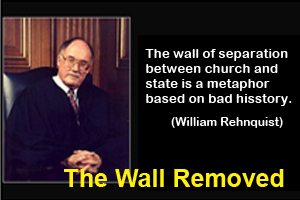

WHAT THE PRESIDENT COULD DO IF HE DECLARES A STATE OF EMERGENCY
Elizabeth Goitein
From seizing control of the internet to declaring martial law, President Trump may legally do all kinds of extraordinary things.
In the weeks leading up to the 2018 midterm elections, President Donald Trump reached deep into his arsenal to try to deliver votes to Republicans.
Most of his weapons were rhetorical, featuring a mix of lies and false inducements—claims that every congressional Democrat had signed on to an “open borders” bill (none had), that liberals were fomenting violent “mobs” (they weren’t), that a 10 percent tax cut for the middle class would somehow pass while Congress was out of session (it didn’t). But a few involved the aggressive use—and threatened misuse—of presidential authority: He sent thousands of activeduty soldiers to the southern border to terrorize a distant caravan of desperate Central American migrants, announced plans to end the constitutional guarantee of birthright citizenship by executive order, and tweeted that law enforcement had been “strongly notified” to be on the lookout for “ILLEGAL VOTING.”
These measures failed to carry the day, and Trump will likely conclude that they were too timid. How much further might he go in 2020, when his own name is on the ballot—or sooner than that, if he’s facing impeachment by a House under Democratic control?
More is at stake here than the outcome of one or even two elections. Trump has long signaled his disdain for the concepts of limited presidential power and democratic rule. During his 2016 campaign, he praised murderous dictators. He declared that his opponent, Hillary Clinton, would be in jail if he were president, goading crowds into frenzied chants of “Lock her up.” He hinted that he might not accept an electoral loss. As democracies around the world slide into autocracy, and nationalism and antidemocratic sentiment are on vivid display among segments of the American populace, Trump’s evident hostility to key elements of liberal democracy cannot be dismissed as mere bluster.
It would be nice to think that America is protected from the worst excesses of Trump’s impulses by its democratic laws and institutions. After all, Trump can do only so much without bumping up against the limits set by the Constitution and Congress and enforced by the courts. Those who see Trump as a threat to democracy comfort themselves with the belief that these limits will hold him in check.
But will they? Unknown to most Americans, a parallel legal regime allows the president to sidestep many of the constraints that normally apply. The moment the president declares a “national emergency”—a decision that is entirely within his discretion—more than 100 special provisions become available to him. While many of these tee up reasonable responses to genuine emergencies, some appear dangerously suited to a leader bent on amassing or retaining power. For instance, the president can, with the flick of his pen, activate laws allowing him to shut down many kinds of electronic communications inside the United States or freeze Americans’ bank accounts. Other powers are available even without a declaration of emergency, including laws that allow the president to deploy troops inside the country to subdue domestic unrest.
This edifice of extraordinary powers has historically rested on the assumption that the president will act in the country’s best interest when using them. With a handful of noteworthy exceptions, this assumption has held up. But what if a president, backed into a corner and facing electoral defeat or impeachment, were to declare an emergency for the sake of holding on to power? In that scenario, our laws and institutions might not save us from a presidential power grab. They might be what takes us down.
- “A LOADED WEAPON”
The premise underlying emergency powers is simple: The government’s ordinary powers might be insufficient in a crisis, and amending the law to provide greater ones might be too slow and cumbersome. Emergency powers are meant to give the government a temporary boost until the emergency passes or there is time to change the law through normal legislative processes.
Unlike the modern constitutions of many other countries, which specify when and how a state of emergency may be declared and which rights may be suspended, the U.S. Constitution itself includes no comprehensive separate regime for emergencies. Those few powers it does contain for dealing with certain urgent threats, it assigns to Congress, not the president. For instance, it lets Congress suspend the writ of habeas corpus—that is, allow government officials to imprison people without judicial review—“when in Cases of Rebellion or Invasion the public Safety may require it” and “provide for calling forth the Militia to execute the Laws of the Union, suppress Insurrections and repel Invasions.”
Nonetheless, some legal scholars believe that the Constitution gives the president inherent emergency powers by making him commander in chief of the armed forces, or by vesting in him a broad, undefined “executive Power.” At key points in American history, presidents have cited inherent constitutional powers when taking drastic actions that were not authorized—or, in some cases, were explicitly prohibited—by Congress. Notorious examples include Franklin D. Roosevelt’s internment of U.S. citizens and residents of Japanese descent during World War II and George W. Bush’s programs of warrantless wiretapping and torture after the 9/11 terrorist attacks. Abraham Lincoln conceded that his unilateral suspension of habeas corpus during the Civil War was constitutionally questionable, but defended it as necessary to preserve the Union.
The Supreme Court has often upheld such actions or found ways to avoid reviewing them, at least while the crisis was in progress. Rulings such as Youngstown Sheet & Tube Company v. Sawyer, in which the Court invalidated President Harry Truman’s bid to take over steel mills during the Korean War, have been the exception. And while those exceptions have outlined important limiting principles, the outer boundary of the president’s constitutional authority during emergencies remains poorly defined.
Presidents can also rely on a cornucopia of powers provided by Congress, which has historically been the principal source of emergency authority for the executive branch. Throughout the late 18th and 19th centuries, Congress passed laws to give the president additional leeway during military, economic, and labor crises. A more formalized approach evolved in the early 20th century, when Congress legislated powers that would lie dormant until the president activated them by declaring a national emergency. These statutory authorities began to pile up—and because presidents had little incentive to terminate states of emergency once declared, these piled up too. By the 1970s, hundreds of statutory emergency powers, and four clearly obsolete states of emergency, were in effect. For instance, the national emergency that Truman declared in 1950, during the Korean War, remained in place and was being used to help prosecute the war in Vietnam.
Aiming to rein in this proliferation, Congress passed the National Emergencies Act in 1976. Under this law, the president still has complete discretion to issue an emergency declaration— but he must specify in the declaration which powers he intends to use, issue public updates if he decides to invoke additional powers, and report to Congress on the government’s emergencyrelated expenditures every six months. The state of emergency expires after a year unless the president renews it, and the Senate and the House must meet every six months while the emergency is in effect “to consider a vote” on termination.
By any objective measure, the law has failed. Thirty states of emergency are in effect today— several times more than when the act was passed. Most have been renewed for years on end. And during the 40 years the law has been in place, Congress has not met even once, let alone every six months, to vote on whether to end them.
As a result, the president has access to emergency powers contained in 123 statutory provisions, as recently calculated by the Brennan Center for Justice at NYU School of Law, where I work. These laws address a broad range of matters, from military composition to agricultural exports to public contracts. For the most part, the president is free to use any of them; the National Emergencies Act doesn’t require that the powers invoked relate to the nature of the emergency. Even if the crisis at hand is, say, a nationwide crop blight, the president may activate the law that allows the secretary of transportation to requisition any privately owned vessel at sea. Many other laws permit the executive branch to take extraordinary action under specified conditions, such as war and domestic upheaval, regardless of whether a national emergency has been declared.
Pablo Martinez Monsivais / AP
This legal regime for emergencies—ambiguous constitutional limits combined with a rich well of statutory emergency powers—would seem to provide the ingredients for a dangerous encroachment on American civil liberties. Yet so far, even though presidents have often advanced dubious claims of constitutional authority, egregious abuses on the scale of the Japanese American internment or the post-9/11 torture program have been rare, and most of the statutory powers available during a national emergency have never been used.
But what’s to guarantee that this president, or a future one, will show the reticence of his predecessors? To borrow from Justice Robert Jackson’s dissent in Korematsu v. United States, the 1944 Supreme Court decision that upheld the internment of Japanese Americans, each emergency power “lies about like a loaded weapon, ready for the hand of any authority that can bring forward a plausible claim of an urgent need.”
2. AN INTERNET KILL SWITCH?
Like all emergency powers, the laws governing the conduct of war allow the president to engage in conduct that would be illegal during ordinary times. This conduct includes familiar incidents of war, such as the killing or indefinite detention of enemy soldiers. But the president can also take a host of other actions, both abroad and inside the United States.
These laws vary dramatically in content and scope. Several of them authorize the president to make decisions about the size and composition of the armed forces that are usually left to Congress. Although such measures can offer needed flexibility at crucial moments, they are subject to misuse. For instance, George W. Bush leveraged the state of emergency after 9/11 to call hundreds of thousands of reservists and members of the National Guard into active duty in Iraq, for a war that had nothing to do with the 9/11 attacks. Other powers are chilling under any circumstances: Take a moment to consider that during a declared war or national emergency, the president can unilaterally suspend the law that bars government testing of biological and chemical agents on unwitting human subjects.
One power poses a singular threat to democracy in the digital era. In 1942, Congress amended Section 706 of the Communications Act of 1934 to allow the president to shut down or take control of “any facility or station for wire communication” upon his proclamation “that there exists a state or threat of war involving the United States,” resurrecting a similar power Congress had briefly provided Woodrow Wilson during World War I. At the time, “wire communication” meant telephone calls or telegrams. Given the relatively modest role that electronic communications played in most Americans’ lives, the government’s assertion of this power during World War II (no president has used it since) likely created inconvenience but not havoc.
We live in a different universe today. Although interpreting a 1942 law to cover the internet might seem far-fetched, some government officials recently endorsed this reading during debates about cybersecurity legislation. Under this interpretation, Section 706 could effectively function as a “kill switch” in the U.S.—one that would be available to the president the moment he proclaimed a mere threat of war. It could also give the president power to assume control over U.S. internet traffic.
The potential impact of such a move can hardly be overstated. In August, in an early-morning tweet, Trump lamented that search engines were “RIGGED” to serve up negative articles about him. Later that day the administration said it was looking into regulating the big internet companies. “I think that Google and Twitter and Facebook, they’re really treading on very, very troubled territory. And they have to be careful,” Trump warned. If the government were to take control of U.S. internet infrastructure, Trump could accomplish directly what he threatened to do by regulation: ensure that internet searches always return pro-Trump content as the top results.
The government also would have the ability to impede domestic access to particular websites, including social-media platforms. It could monitor emails or prevent them from reaching their destination. It could exert control over computer systems (such as states’ voter databases) and physical devices (such as Amazon’s Echo speakers) that are connected to the internet.
Video: Trump’s Emergency Powers Are “Ripe for Abuse”
To be sure, the fact that the internet in the United States is highly decentralized—a function of a relatively open market for communications devices and services—would offer some protection. Achieving the level of government control over internet content that exists in places such as China, Russia, and Iran would likely be impossible in the U.S. Moreover, if Trump were to attempt any degree of internet takeover, an explosion of lawsuits would follow. Based on its First Amendment rulings in recent decades, the Supreme Court seems unlikely to permit heavyhanded government control over internet communication.
But complacency would be a mistake. Complete control of internet content would not be necessary for Trump’s purposes; even with less comprehensive interventions, he could do a great deal to disrupt political discourse and hinder effective, organized political opposition. And the Supreme Court’s view of the First Amendment is not immutable. For much of the country’s history, the Court was willing to tolerate significant encroachments on free speech during wartime. “The progress we have made is fragile,” Geoffrey R. Stone, a constitutional-law scholar at the University of Chicago, has written. “It would not take much to upset the current understanding of the First Amendment.” Indeed, all it would take is five Supreme Court justices whose commitment to presidential power exceeds their commitment to individual liberties.
Download







